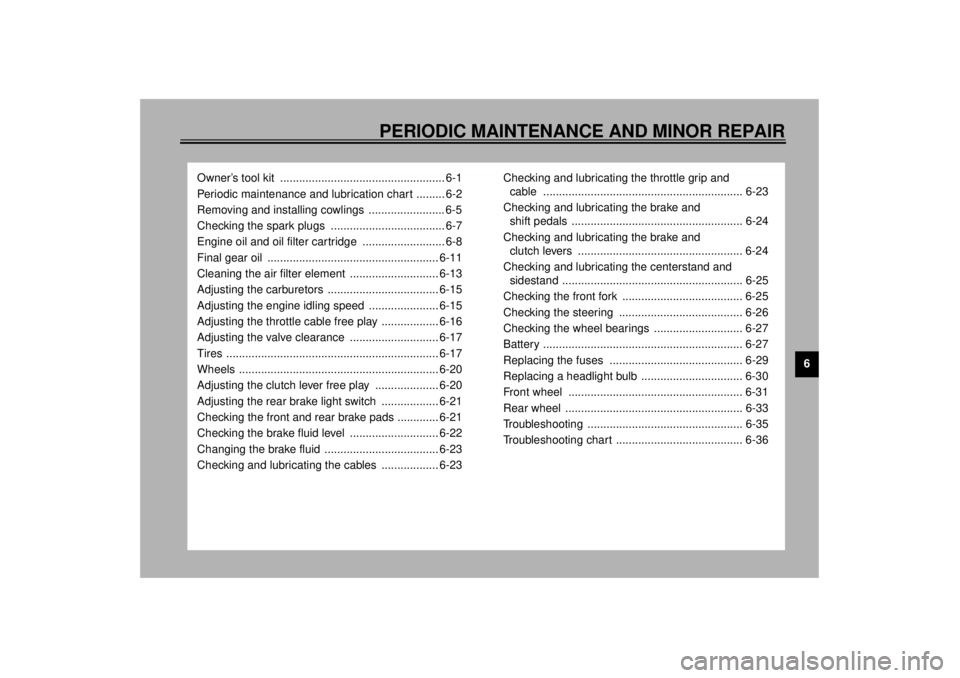2001 YAMAHA XJ900S oil level
[x] Cancel search: oil levelPage 13 of 100

DESCRIPTION
2-2
2
Right view8. Tail/brake light
9. Fuse boxes (page 6-29)
10. Seat (page 3-11)
11. Owner’s tool kit (page 6-1)
12. Air filter element (page 6-13)13. Front fork spring preload
adjusting bolt (page 3-13)
14. Engine oil level check window (page 6-8)
15. Brake pedal (page 3-8)
E_4km.book Page 2 Thursday, September 7, 2000 9:32 AM
Page 17 of 100

INSTRUMENT AND CONTROL FUNCTIONS
3-2
3
EAU01590
(Parking)
The steering is locked, and the taillight
and auxiliary light are on, but all other
electrical systems are off. The key can
be removed.
The steering must be locked before the
key can be turned to “ ”.
ECA00043
CAUTION:@ Do not use the parking position for
an extended length of time, other-
wise the battery may discharge. @
EAU03034
Indicator and warning lights
EAU03299
Turn signal indicator lights
“” / “”
The corresponding indicator light flash-
es when the turn signal switch is
pushed to the left or right.
EAU03680
Fuel level warning light “ ”
This warning light comes on when the
fuel level drops below approximately
5 L. When this occurs, refuel as soon
as possible.
The electrical circuit of the warning light
can be checked according to the fol-
lowing procedure.
1. Set the engine stop switch to “ ”
and turn the key to “ON”.
2. Shift the transmission into the neu-
tral position or pull the clutch lever.
3. Push the start switch. If the warn-
ing light does not come on, have a
Yamaha dealer check the electri-
cal circuit.
1. Left turn signal indicator light “ ”
2. Fuel level warning light “ ”
3. Neutral indicator light “ ”
4. High beam indicator light “ ”
5. Oil level warning light “ ”
6. Right turn signal indicator light “ ”
E_4km.book Page 2 Thursday, September 7, 2000 9:32 AM
Page 18 of 100

INSTRUMENT AND CONTROL FUNCTIONS
3-3
3
EAU00061
Neutral indicator light “ ”
This indicator light comes on when the
transmission is in the neutral position.
EAU00063
High beam indicator light “ ”
This indicator light comes on when the
high beam of the headlight is switched
on.
EAU03201
Oil level warning light “ ”
This warning light comes on when the
engine oil level is low.
The electrical circuit of the warning light
can be checked according to the fol-
lowing procedure.
1. Set the engine stop switch to “ ”
and turn the key to “ON”.
2. Shift the transmission into the neu-
tral position or pull the clutch lever.
3. Push the start switch. If the warn-
ing light does not come on while
pushing the start switch, have a
Yamaha dealer check the electri-
cal circuit.NOTE:@ Even if the oil level is sufficient, the
warning light may flicker when riding on
a slope or during sudden acceleration
or deceleration, but this is not a mal-
function. @
EAU00094
Speedometer unit The speedometer unit is equipped with
a speedometer, an odometer and a
tripmeter. The speedometer shows
riding speed. The odometer shows the
total distance traveled. The tripmeter
shows the distance traveled since it
was last set to zero with the reset but-
ton. The tripmeter can be used to esti-
mate the distance that can be traveled
with a full tank of fuel. This information
will enable you to plan future fuel stops.
1. Left turn signal indicator light “ ”
2. Fuel level warning light “ ”
3. Neutral indicator light “ ”
4. High beam indicator light “ ”
5. Oil level warning light “ ”
6. Right turn signal indicator light “ ”
1. Tripmeter
2. Odometer
3. Tripmeter reset button
E_4km.book Page 3 Thursday, September 7, 2000 9:32 AM
Page 34 of 100

4-1
4
EAU01114
4-PRE-OPERATION CHECKSThe condition of a vehicle is the owner’s responsibility. Vital components can start to deteriorate quickly and unexpectedly,
even if the vehicle remains unused (for example, as a result of exposure to the elements). Any damage, fluid leakage or loss
of tire air pressure could have serious consequences. Therefore, it is very important, in addition to a thorough visual inspec-
tion, to check the following points before each ride.
EAU03439
Pre-operation check list
ITEM CHECKS PAGE
Fuel• Check fuel level in fuel tank.
• Refuel if necessary.
• Check fuel line for leakage.3-9–3-10
Engine oil• Check oil level in engine.
• If necessary, add recommended oil to specified level.
• Check vehicle for oil leakage.6-8
Final gear oil• Check vehicle for oil leakage. 6-11–6-12
Front brake• Check operation.
• If soft or spongy, have Yamaha dealer bleed hydraulic system.
• Check fluid level in reservoir.
• If necessary, add recommended brake fluid to specified level.
• Check hydraulic system for leakage.6-21–6-23
Rear brake• Check operation.
• If soft or spongy, have Yamaha dealer bleed hydraulic system.
• Check fluid level in reservoir.
• If necessary, add recommended brake fluid to specified level.
• Check hydraulic system for leakage.6-21–6-23
Clutch• Check operation.
• Lubricate cable if necessary.
• Check lever free play.
• Adjust if necessary.6-20
Throttle grip• Make sure that operation is smooth.
• Lubricate throttle grip, housing and cables if necessary.
• Check free play.
• If necessary, have Yamaha dealer make adjustment.6-16, 6-23–6-24
Control cables• Make sure that operation is smooth.
• Lubricate if necessary.6-23
E_4km.book Page 1 Thursday, September 7, 2000 9:32 AM
Page 39 of 100

OPERATION AND IMPORTANT RIDING POINTS
5-2
5
NOTE:@ If the engine fails to start, release the
start switch, wait a few seconds, and
then try again. Each starting attempt
should be as short as possible to pre-
serve the battery. Do not crank the en-
gine more than 10 seconds on any one
attempt. @
EC000038
CAUTION:@ l
The oil level warning light and
fuel level warning light should
come on when the start switch
is pushed, and they should go
off when the start switch is re-
leased.
l
If the oil level warning light flick-
ers or remains on after starting,
immediately stop the engine,
and then check the engine oil
level and the vehicle for oil leak-
age. If necessary, add engine
oil, and then check the warning
light again. If the warning light
does not come on when push-
ing the start switch, or if it doesnot go off after starting with suf-
ficient engine oil, have a
Yamaha dealer check the elec-
trical circuit.
l
If the fuel level warning light re-
mains on after starting, stop the
engine, and then check the fuel
level. If necessary, refuel as
soon as possible, and then
check the warning light again. If
the warning light does not come
on when pushing the start
switch, or if it does not go off af-
ter starting with sufficient fuel,
have a Yamaha dealer check the
electrical circuit.
@5. After starting the engine, move the
starter (choke) lever back halfway.
ECA00045
CAUTION:@ For maximum engine life, never ac-
celerate hard when the engine is
cold! @6. When the engine is warm, turn the
starter (choke) off.
NOTE:@ l
The engine is warm when it re-
sponds normally to the throttle
with the starter (choke) turned off.
l
When the engine is idling with the
starter (choke) on, the radiator fan
will automatically be switched on
and off regardless of the radiator
coolant temperature, and the en-
gine idling speed will vary at times,
but this is not a malfunction.
@
E_4km.book Page 2 Thursday, September 7, 2000 9:32 AM
Page 43 of 100

6
PERIODIC MAINTENANCE AND MINOR REPAIR
Owner’s tool kit .................................................... 6-1
Periodic maintenance and lubrication chart ......... 6-2
Removing and installing cowlings ........................ 6-5
Checking the spark plugs .................................... 6-7
Engine oil and oil filter cartridge .......................... 6-8
Final gear oil ...................................................... 6-11
Cleaning the air filter element ............................ 6-13
Adjusting the carburetors ................................... 6-15
Adjusting the engine idling speed ...................... 6-15
Adjusting the throttle cable free play .................. 6-16
Adjusting the valve clearance ............................ 6-17
Tires ................................................................... 6-17
Wheels ............................................................... 6-20
Adjusting the clutch lever free play .................... 6-20
Adjusting the rear brake light switch .................. 6-21
Checking the front and rear brake pads ............. 6-21
Checking the brake fluid level ............................ 6-22
Changing the brake fluid .................................... 6-23
Checking and lubricating the cables .................. 6-23Checking and lubricating the throttle grip and
cable ............................................................... 6-23
Checking and lubricating the brake and
shift pedals ...................................................... 6-24
Checking and lubricating the brake and
clutch levers .................................................... 6-24
Checking and lubricating the centerstand and
sidestand ......................................................... 6-25
Checking the front fork ...................................... 6-25
Checking the steering ....................................... 6-26
Checking the wheel bearings ............................ 6-27
Battery ............................................................... 6-27
Replacing the fuses .......................................... 6-29
Replacing a headlight bulb ................................ 6-30
Front wheel ....................................................... 6-31
Rear wheel ........................................................ 6-33
Troubleshooting ................................................. 6-35
Troubleshooting chart ........................................ 6-36
E_4km.book Page 1 Thursday, September 7, 2000 9:32 AM
Page 46 of 100

PERIODIC MAINTENANCE AND MINOR REPAIR
6-3
6
10
*Wheels• Check runout and for damage.ÖÖÖÖ
11*Tires• Check tread depth and for damage.
• Replace if necessary.
• Check air pressure.
• Correct if necessary.ÖÖÖÖ
12*Wheel bearings• Check bearing for looseness or damage.ÖÖÖÖ
13*Swingarm• Check operation and for excessive play.ÖÖÖÖ
• Lubricate with lithium-soap-based grease. Every 50,000 km
14*Steering bearings• Check bearing play and steering for roughness.ÖÖÖÖÖ
• Lubricate with lithium-soap-based grease. Every 20,000 km
15*Chassis fasteners• Make sure that all nuts, bolts and screws are properly tightened.ÖÖÖÖ Ö
16 Sidestand/centerstand• Check operation.
• Lubricate.ÖÖÖÖ Ö
17*Sidestand switch• Check operation.ÖÖÖÖÖ Ö
18*Front fork• Check operation and for oil leakage.ÖÖÖÖ
19*Rear shock absorber
assembly• Check operation and shock absorber for oil leakage.ÖÖÖÖ
20*Rear suspension relay
arm and connecting arm
pivoting points• Check operation.ÖÖÖÖ
• Lubricate with molybdenum disulfide grease.ÖÖ
21*Carburetors• Check starter (choke) operation.
• Adjust engine idling speed and synchronization.ÖÖÖÖÖ Ö
22 Engine oil• Change.ÖÖÖÖÖ Ö
23 Engine oil filter cartridge•Replace.ÖÖÖ
24 Final gear oil• Check oil level and vehicle for oil leakage.ÖÖ Ö
• Change.ÖÖÖ NO. ITEM CHECK OR MAINTENANCE JOBODOMETER READING (´1,000 km)
ANNUAL
CHECK
1 10203040
E_4km.book Page 3 Thursday, September 7, 2000 9:32 AM
Page 51 of 100

PERIODIC MAINTENANCE AND MINOR REPAIR
6-8
6
NOTE:@ If a torque wrench is not available when
installing a spark plug, a good estimate
of the correct torque is 1/4–1/2 turn
past finger tight. However, the spark
plug should be tightened to the speci-
fied torque as soon as possible. @
EAU02938
Engine oil and oil filter
cartridge The engine oil level should be checked
before each ride. In addition, the oil
must be changed and the oil filter car-
tridge replaced at the intervals speci-
fied in the periodic maintenance and
lubrication chart.
To check the engine oil level
1. Place the motorcycle on the cen-
terstand.NOTE:@ Make sure that the motorcycle is posi-
tioned straight up when checking the oil
level. A slight tilt to the side can result in
a false reading. @2. Start the engine, warm it up for
several minutes, and then turn it
off.3. Wait a few minutes until the oil set-
tles, and then check the oil level
through the check window located
at the bottom-right side of the
crankcase.
NOTE:@ The engine oil should be between the
minimum and maximum level marks. @4. If the engine oil is below the mini-
mum level mark, add sufficient oil
of the recommended type to raise
it to the correct level.1. Engine oil level check window
2. Maximum level mark
3. Minimum level mark
E_4km.book Page 8 Thursday, September 7, 2000 9:32 AM